Symbol of Turkish - Jewish Amity: The Zulfaris Synagogue
By Naim Güleryüz
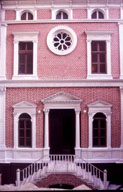 A city straddling two continents, Asia and Europe, Istanbul is at the same time a bridge linking Eastern and Western cultures. It is the world's only city where for five centuries people have worshipped in peace and harmony at mosques, synagogues and churches standing side by side. This remarkable city where different faiths meet saw a new addition to its cultural heritage on 25 November 2001 when the Museum of Turkish Jews was opened. The museum has been founded by the Quincentennial Foundation, whose objective is to commemorate the amicable relations between Turks and Jews which began in 1326 with the Ottoman conquest of Bursa - where there was already a thriving Jewish community, and were cemented when the Ottoman Turks offered a new homeland to the Sephardic Jews who preferred to leave their Spanish homeland rather than lose their religious freedom. The Zülfaris Synagogue, which stands on Perçemli Sokak in the Karaköy district of Istanbul, has been restored by the foundation and reopened as a museum.
A city straddling two continents, Asia and Europe, Istanbul is at the same time a bridge linking Eastern and Western cultures. It is the world's only city where for five centuries people have worshipped in peace and harmony at mosques, synagogues and churches standing side by side. This remarkable city where different faiths meet saw a new addition to its cultural heritage on 25 November 2001 when the Museum of Turkish Jews was opened. The museum has been founded by the Quincentennial Foundation, whose objective is to commemorate the amicable relations between Turks and Jews which began in 1326 with the Ottoman conquest of Bursa - where there was already a thriving Jewish community, and were cemented when the Ottoman Turks offered a new homeland to the Sephardic Jews who preferred to leave their Spanish homeland rather than lose their religious freedom. The Zülfaris Synagogue, which stands on Perçemli Sokak in the Karaköy district of Istanbul, has been restored by the foundation and reopened as a museum.
The name Zülfaris, by which this street was formerly known, is the colloquial form of the term zülf-ü arus, meaning 'bridal curls'. The present name Perçemli has the same meaning in modern Turkish, and refers to the many brides who passed down the street on their way to be married at the synagogue over the centuries.
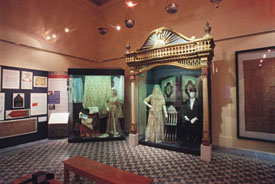 In the courtyard in front of the synagogue is a sculpture by Nadia Arditti. Entitled The Soaring Flame, it is a monument in memory of the Jewish soldiers of Turkey who lost their lives defending their homeland in World War I and the War of Independence. I ascended the staircase which countless brides had walked up on the arms of their fathers and walked down on the arms of their husbands, and entered the main hall.
In the courtyard in front of the synagogue is a sculpture by Nadia Arditti. Entitled The Soaring Flame, it is a monument in memory of the Jewish soldiers of Turkey who lost their lives defending their homeland in World War I and the War of Independence. I ascended the staircase which countless brides had walked up on the arms of their fathers and walked down on the arms of their husbands, and entered the main hall.
Amicable relations between Turks and Jews is symbolized by the illuminated image of a tallit (prayer shawl) bearing a star and crescent motif. Beneath this is a touch-screen computer providing information about the principal Jewish communities in Turkey at various periods. Panels and maps tell the story of the Spanish Jews from the golden age of the Andalusian period.
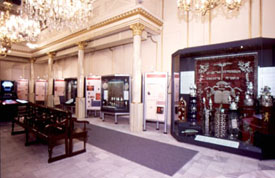 Visitors learn how the Sephardic Jews were obliged to leave Spain after Ferdinand and Isabella issued the Expulsion Edict of 31 March 1492, how they dispersed to many countries and were offered a new home in the Ottoman Empire by Sultan Bayezid II (1481-1512). Exhibits include the warrant of exemption from tax granted to the Jews of Buda by Sultan Süleyman the Magnificent, and the historic Edirne Letter written by Rabbi Sarfati of Edirne, calling on the persecuted Jews of Europe to migrate to Ottoman Turkey.
Visitors learn how the Sephardic Jews were obliged to leave Spain after Ferdinand and Isabella issued the Expulsion Edict of 31 March 1492, how they dispersed to many countries and were offered a new home in the Ottoman Empire by Sultan Bayezid II (1481-1512). Exhibits include the warrant of exemption from tax granted to the Jews of Buda by Sultan Süleyman the Magnificent, and the historic Edirne Letter written by Rabbi Sarfati of Edirne, calling on the persecuted Jews of Europe to migrate to Ottoman Turkey.
Turkish motifs on Judaic religious objects reflect the extent to which Jews became an integral part of Turkish society as a result of religious tolerance. Examples of these are on display alongside Torah scrolls. One panel tells the story of the Chief Rabbinate in Turkey, and another illustrates the appointment warrant, seal and medal of Rav Moshe Ben Habib, Chief Rabbi of Bursa. The Ehal, which is the holiest section of the synagogue is symbolically marked by two Torah scrolls, one of which is unrolled.
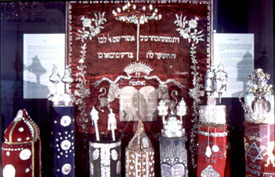 Although the Sephardim left all their valuables behind when they fled Spain, they brought with them their rich cultural heritage dating from the Andalusian golden age. The first printing press in Ottoman Turkey was established by David and Samuel ibn Nahmias in 1493, and the displays in the right wing of the main hall begin with a glass case and panel on this theme. Here we can see a copy of Midrash Teilim, a book printed in Istanbul in 1512. One section is devoted to the history of the Jewish press in Turkey, with examples of numerous different publications. Another contribution of the Jewish migrants to Ottoman culture was in the field of classical Turkish music, to which a glass case and panel are devoted.
Although the Sephardim left all their valuables behind when they fled Spain, they brought with them their rich cultural heritage dating from the Andalusian golden age. The first printing press in Ottoman Turkey was established by David and Samuel ibn Nahmias in 1493, and the displays in the right wing of the main hall begin with a glass case and panel on this theme. Here we can see a copy of Midrash Teilim, a book printed in Istanbul in 1512. One section is devoted to the history of the Jewish press in Turkey, with examples of numerous different publications. Another contribution of the Jewish migrants to Ottoman culture was in the field of classical Turkish music, to which a glass case and panel are devoted.
The exhibits go on to examine the contribution made by the Turkish Jews to Ottoman society, with documents and objects relating to several celebrated Turkish Jews.
Other panels focus on the numerous scholars who fled Nazi Germany and pursued their academic careers at Turkish universities, and the stories of Turkish diplomats who managed to save countless Jews from death in the concentration camps in the countries where they were serving during World War II. In the upper gallery reserved for women in the days when the synagogue was used for worship are exhibits relating to the 400th and 500th anniversary celebrations, Turkey's Ashkenazi community and the Moris Sinasi Children's Hospital in Manisa.
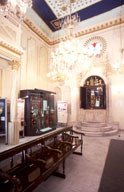 Descending the staircase to the ground floor, you come to the Ethnographic Section, with reconstructions of scenes illustrating birth and circumcision, the trousseau and marriage. Here you can also see two marriage contracts, and a fascinating series of photographs of brides and grooms arranged in chronological order from the 1860s to the 1960s which carry visitors through a time tunnel.
Descending the staircase to the ground floor, you come to the Ethnographic Section, with reconstructions of scenes illustrating birth and circumcision, the trousseau and marriage. Here you can also see two marriage contracts, and a fascinating series of photographs of brides and grooms arranged in chronological order from the 1860s to the 1960s which carry visitors through a time tunnel.
Costumes, including wedding gowns, talismans, jewelry and many other items reflect the culture of Turkey's Jewish communities over the centuries.
Before leaving the museum I wrote in the visitors book, and stopped to read the last panel, on which were summaries of statements concerning the Turkish Jews by Atatürk, Ismet Inönü, Turgut Özal, Süleyman Demirel and Mesut Yilmaz.
* Naim Güleryüz is a researcher and writer, and vice president of the Quincentennial Foundation.